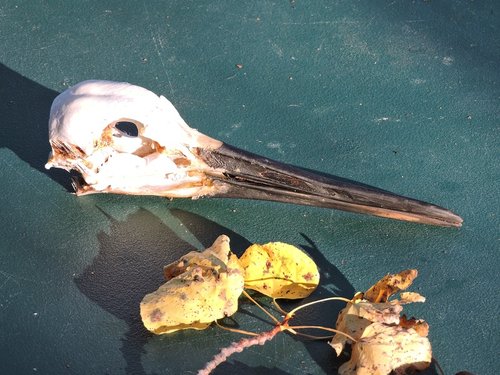This story starts with a huge “Thanks You” to Rat Fink. Through personal communications on HuntTalk, he lined me out about hunting sand hill crane in western Montana.
I followed his advice and on my fourth day of hunting knocked down a large crane. The first day I showed up at day light and walked into brand new territory for me. It was along a large lake 80 miles from my home.
I heard sand hills within the first 30 minutes of walking but it only sounded like one or two birds. It turned out that there were only four or five birds on the whole lake. I put on five miles of hiking trying to locate the birds and figure out where there were going to leave the lake and head for the grain fields.
I didn’t figure it out for three more days, but I finally got under the exit path of two birds. I took the bigger of the two and dropped him with one shot. It was a mile carry back to the truck. He is an absolutely gorgeous bird. Gold eyes, blue-grey feathers with splashes of brown. And the size or a small whitetail.
There has been much discussion about the edibility of sand hills on this blog, so I decided to treat the breast muscles as if they were venison hind quarter muscles or maybe a back strap. The sand hill breast muscles are about the same size has a large goose. The one I have has large muscle fibers and was a little tough as I took it off the breast bone. However, there was no strong smell. It didn’t smell gamey or like strong waterfowl. It did not smell sweet either. It smelled like it would have a normal venison flavor, which it did.
After removing the two muscles, I coated them with a little salt, a bunch of Mrs. Dash lemon pepper, some liquid smoke and a little MSG. I covered with some vegetable oil and placed them in a closed container in the refrigerator for four days.
Since I was going to treat it like venison steak, I cut a few thick slices across the grain from the small end of one of the muscles. I fried them in a cast iron skittle over medium high heat in butter. I pulled them out when they were very pink inside and a little blood ran out when cut.
They had a perfectly acceptable venison flavor. The muscle fibers needed a knife to cut but they were not super tough to eat. They are not “rib eyes.” At least not the rib roast cuts I get at the Oasis in Logan, MT. Those are tender and have lots of fat dripping off them. Few cuts of wild game except back straps and inside tenderloins can compete with the rib roasts from the Oasis. Two different animals, literally.
I put horseradish on each bite just as I do beef rib eye steaks. It was very good. I wouldn’t hesitate to serve them to anyone who enjoys venison steaks. They are not as good as venison back straps and tenderloins however.
Bart with crane
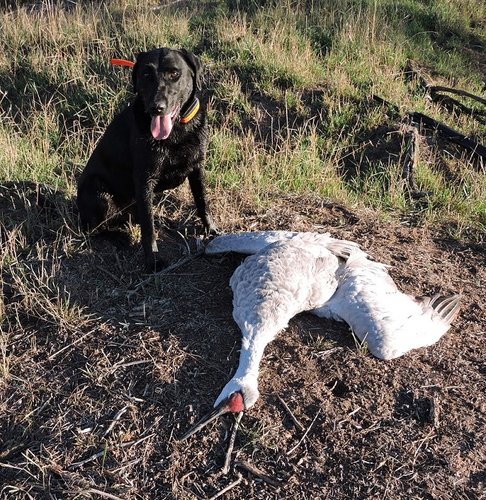
Crane head
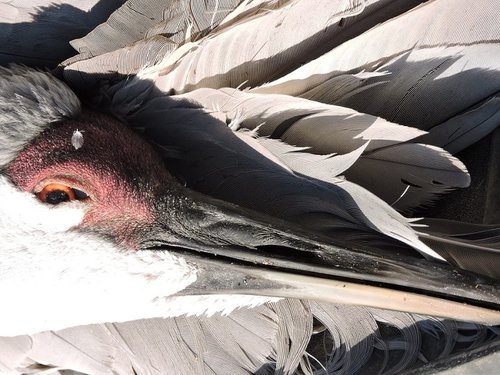
"Steaks in skillet"
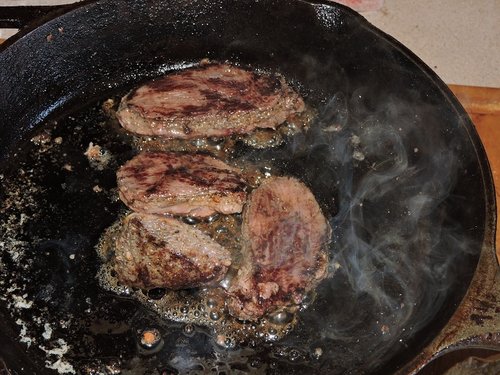
Horseradish for crane, green sauce for eggs

Grandsons #1 and #2
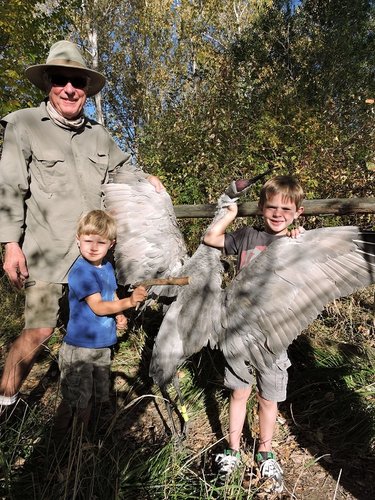
Grandson #3 with wing
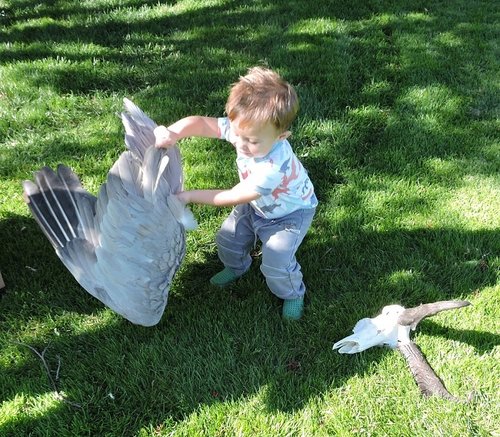
I followed his advice and on my fourth day of hunting knocked down a large crane. The first day I showed up at day light and walked into brand new territory for me. It was along a large lake 80 miles from my home.
I heard sand hills within the first 30 minutes of walking but it only sounded like one or two birds. It turned out that there were only four or five birds on the whole lake. I put on five miles of hiking trying to locate the birds and figure out where there were going to leave the lake and head for the grain fields.
I didn’t figure it out for three more days, but I finally got under the exit path of two birds. I took the bigger of the two and dropped him with one shot. It was a mile carry back to the truck. He is an absolutely gorgeous bird. Gold eyes, blue-grey feathers with splashes of brown. And the size or a small whitetail.
There has been much discussion about the edibility of sand hills on this blog, so I decided to treat the breast muscles as if they were venison hind quarter muscles or maybe a back strap. The sand hill breast muscles are about the same size has a large goose. The one I have has large muscle fibers and was a little tough as I took it off the breast bone. However, there was no strong smell. It didn’t smell gamey or like strong waterfowl. It did not smell sweet either. It smelled like it would have a normal venison flavor, which it did.
After removing the two muscles, I coated them with a little salt, a bunch of Mrs. Dash lemon pepper, some liquid smoke and a little MSG. I covered with some vegetable oil and placed them in a closed container in the refrigerator for four days.
Since I was going to treat it like venison steak, I cut a few thick slices across the grain from the small end of one of the muscles. I fried them in a cast iron skittle over medium high heat in butter. I pulled them out when they were very pink inside and a little blood ran out when cut.
They had a perfectly acceptable venison flavor. The muscle fibers needed a knife to cut but they were not super tough to eat. They are not “rib eyes.” At least not the rib roast cuts I get at the Oasis in Logan, MT. Those are tender and have lots of fat dripping off them. Few cuts of wild game except back straps and inside tenderloins can compete with the rib roasts from the Oasis. Two different animals, literally.
I put horseradish on each bite just as I do beef rib eye steaks. It was very good. I wouldn’t hesitate to serve them to anyone who enjoys venison steaks. They are not as good as venison back straps and tenderloins however.
Bart with crane

Crane head

"Steaks in skillet"

Horseradish for crane, green sauce for eggs

Grandsons #1 and #2

Grandson #3 with wing





